 |
||
|
||
| ||
400 GB for Business and PleasureAfter our acquaintance with the 400GB professional Serial ATA hard disk drive of the NL35 series from Seagate in comparison with a number of competing products and its direct ancestor from the desktop series Seagate Barracuda 7200.8, we should focus on two other 400GB twin-models, one of which also belongs to the Desktop segment, while the other is presented as a professional drive, though it descends from the first model. We are going to review the first 400GB hard disk drive from Western Digital in the Caviar SE16 series and its heir from the new WD Caviar RE2 series — WD4000KD and WD4000YR correspondingly. 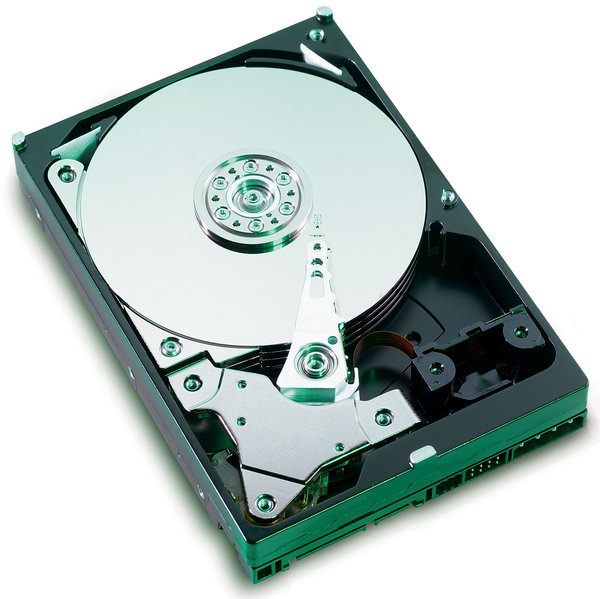
Insides of WD Caviar RE2 WD4000YR (WD4000KD).
WD has finally crossed its Rubicon with these two models and has introduced the 4-platter design into production. Frankly speaking, I don't remember those ancient times when WD used to manufacture hard disk drives with four platters. At least it seems to me that WD had no such models in the observable past (that is since GMR heads). In fact, WD has always been rather secretive as to a number of heads and platters in some of its models, preferring to vary these parameters "on the fly" to keep the manufacturing process "flexible". And now, capacities of the GMR technology for increasing data density are practically used up, WD is stubbornly reluctant to introduce TMR heads and perpendicular recording into mass-production models. And the only way to increase HDD capacity (it's a must, because time and users demand it) is to increase the number of platters and heads. Top models from Hitachi GST have been using 5 and 10 of them correspondingly. Seagate managed to make the advance of 400 GB with only three platters (but later on it was still forced to use 4 platters to reach 500 GB). And WD was actually the third company on the market, who crossed the 400GB bar in mid 2005, having left Maxtor and Samsung behind. And it was the second company on the market to "return" to the 4-platter configuration in Desktop drives. It also started using 16 MB buffers and a number of other interesting technologies. In fact, WD4000KD drives are the first WD models to support Native Command Queuing (NCQ), as WD could only boast of support for the outdated TCQ in 2nd-generation Raptors.
WD Caviar SE16 and Caviar RE2 in the High-Capacity sectorWe have already reviewed WD Caviar SE16 series in Mid-Capacity sector. So we'll just note that the first 400GB model of this series differs from the other models in the following: (a) it's the first model to use 4 platters instead of three, that is it's equipped with an absolutely new case (hermetic unit), (b) it uses a different disk controller supporting NCQ and Serial ATA 1.5 Gbit/s, while the other HDDs of this series feature Serial ATA II with the data transfer rate of up to 3 Gbit/s. 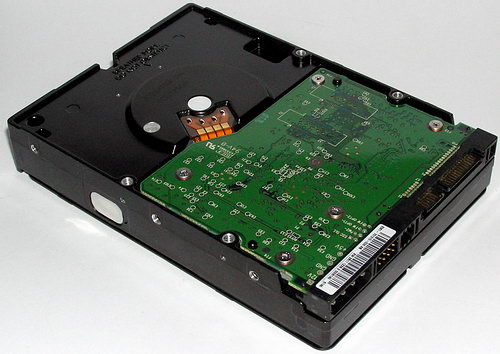  WD hard drives of the Caviar SE16 series (back view): WD4000KD 400GB model (on top) and WD2500KS (WD3200KS of lower capacity) (below).
WD4000KD is actually a special model in this series, it differs from the other models in exterior and interior. Thus, it requires special treatment as well. :) 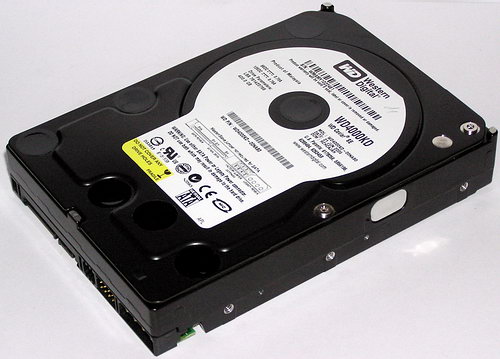  WD hard drives of the Caviar SE16 series: WD4000KD 400GB model (on top) and WD2500KS (WD3200KS of lower capacity) (below).
The situation with the WD400YR is simpler. With the rotational speed of 7200rpm, Serial ATA 1.5Gbit/s interface (with NCQ), and other technologies and components of desktop WD drives from the Caviar SE16 series, to be more exact — WD4000KD models, Caviar RE2 series hard drives (represented by the firstborn WD4000YR) are designed for professional applications in the first place, for example for data storage systems or servers/workstations with RAIDs. That is they are more reliable compared to their desktop counterparts and most likely have different firmware. We'll try to find out how much different they are from the traditional Caviar SE16 drives.  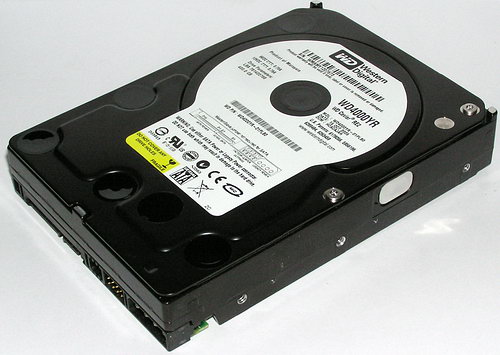 400GB WD hard drives: WD4000KD (on top) and WD4000YR (below).
These two drives (WD4000KD and WD4000YR) are just uniovular twins in exterior, even their mother (WD? ;)) can hardly distinguish between them. :) The difference can be exposed only by the designation:   Controller boards of these two 400GB hard drives from different series are also identical and noticeably different from those in the other Caviar SE16 series drives with Serial ATA II interface and a newer Marvell 88i6545 microcontroller. 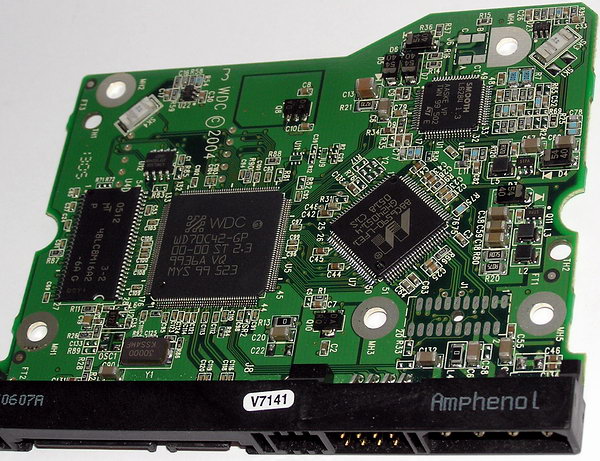 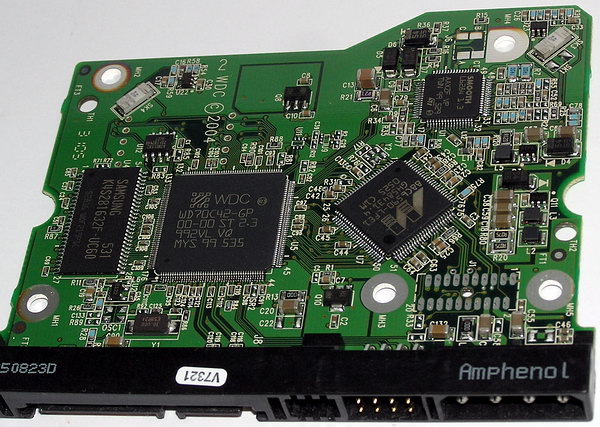  Controller boards of top hard drives - WD4000KD (on top) and WD4000YR (below). The main chips, used in these controllers, are shown below.
Note that in this case WD uses a dual-chip design (instead of a more traditional single-chip design), when WD70C42 controller is responsible for Serial ATA and cache exchange, while Marvell 88C6590 chip controls heads (all these functions are up to a single compact chip Marvell 88i6545 in other modern WD drives of lesser capacity, though two years ago WD also used a dual-chip "heart" of the controller in WD2500JD drives, based on a couple of WD70C26 and Marvell microcontrollers, see our review). Of course, this solution was forced by the necessity to work with 8 heads and 4 platters. The last fact was partly a reason for replacing the electromechanical driver - a new Smooth L6284 chip instead of Smooth L6283, used in less capacious models from WD.  A fragment of the controller board in WD4000KD and WD4000YR drives.
By the way, the last photo shows another important radio element that first appeared in the WD4000KD: it's an acceleration sensor (top left corner of the photo). Our models under review have two of them in opposite corners of the board. They measure HDD operation vibrations and allow the controller to promptly compensate for parasitic microshifts/microaccelerations of the slider with heads, caused by these vibrations. That is they allow fast and precise track positioning even in conditions of high vibrations. This WD technology is called RAFF (Rotary Acceleration Feed Forward). This technology has had an immediate effect: the graph below (plotted in a WD laboratory) shows the relation of data transfer rate performance versus a vibe level in a hard drive within the 10-500 Hz range. 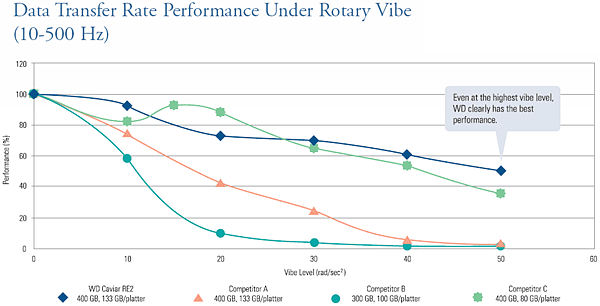 It's not hard to guess that competitors of the WD4000KD/YR are Seagate Barracuda 7200.8 (pink), Maxtor MaXLine III (dark cyan), and Hitachi Deskstar 7K400 (green). The results are illustrative: in fact, in high-vibration conditions, only 5-platter Hitachi drive (by the way, it's equipped with a similar technology) can compete with the WD4000YR in data transfer rates. But the fastest drive on the highest vibe level of 30-50 rad/sec^2 is still the WD model, it loses only 30-50% of its speed, while its competitors lose much more of it. Frankly speaking, the level of self-vibration and acoustic noise of the WD4000KD/YR drives I tested was noticeably higher than even that in the three-platter WD models from similar series. That is the vibe compensation has been added on purpose. At the same time, it allows such a drive to demonstrate a "smooth" graph of linear reading even when it lies freely, while most other modern drives of high capacity can produce such a "smooth" graph only when secured on massive racks (you shouldn't neglect it during tests and full-time operation). :) Among other construction peculiarities of these drives we can mention a thick cover of the hard drive (to accommodate four platters), a special groove in the HDD case for the board with projections for the two hottest chips (Smooth and WDC) for better cooling. 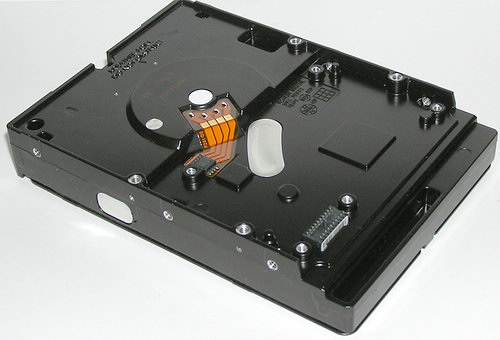 There is a pad between the logic board and the HDD case for better heat removal and electric insulation.  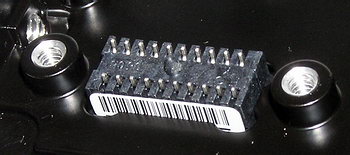 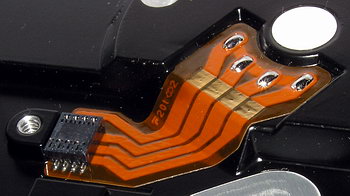 Some components of the drives WD4000YR and WD4000KD under the logic board.
And the pressure spiked electric connectors are used for signals from the heads and actuator control as well as for the spindle (see the photo below). Both of them are pressed to the board with closely placed screw joints. Key specifications on the drives are published in the table.
First of all, characteristics of the latest 500GB WD5000YS model of the Caviar RE2 series (it didn't reach the end user yet, when we wrote this article) differ from those of the WD4000YR. That's why we focus on the 400-GB model here. Key features of the WD4000KD and WD4000YR drives:
Here are the key differences between WD4000YR and WD4000KD (according to the specs):
WD publishes the following description of the TLER technology on the web site (time-limited error recovery): "Desktop drives are designed to protect and recover data, at times pausing for as much as a few minutes to make sure that data is recovered. Inside a RAID system, where the RAID controller handles error recovery, the drive needn't pause for extended periods to recover data. In fact, heroic error recovery attempts can cause a RAID system to drop a drive out of the array. WD RE2 is engineered to prevent hard drive error recovery fallout by limiting the drive's error recovery time. With error recovery factory set to seven seconds, the drive has time to attempt a recovery, allow the RAID controller to log the error, and still stay online." Serial ATA 3.0 Gbit/s is used in Caviar SE16 KS models (that is all models except WD4000KD) as well as in all newer Caviar RE2 drives except WD4000YR (their designations end in YS). WD does not use special audio-video-commands in these drives (aka Streaming Feature Set). That's how WD puts it: "A/V extensions offered by some competitors are relics of a time when hard drives were much slower and required extensive error handling logic when overwhelmed by the application. Today's much faster hard drives make these extensions unnecessary. We urge you to test WD RE2 in your A/V environment." Here is the situation with Native Command Queuing (NCQ) in these drives. All Caviar RE2 drives, including WD4000YR and later YS models support NCQ with queue depth of up to 32 commands. 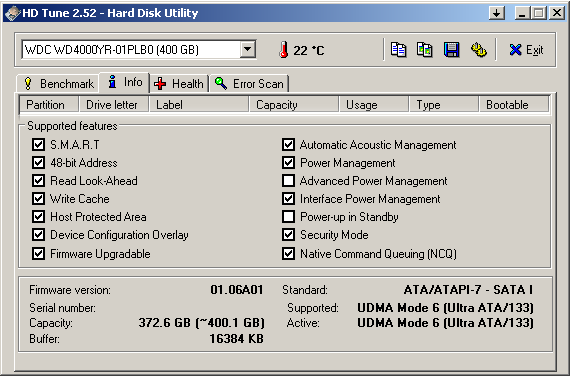 WD proudly publishes the results of server tests, where WD4000YR with an NCQ-host controller demonstrates excellent results: 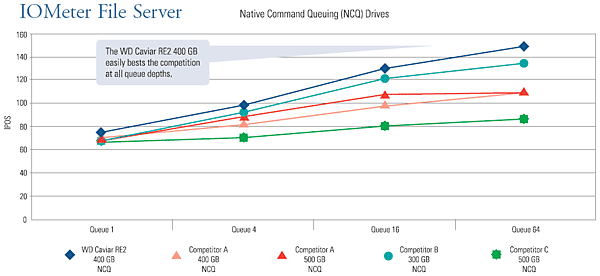 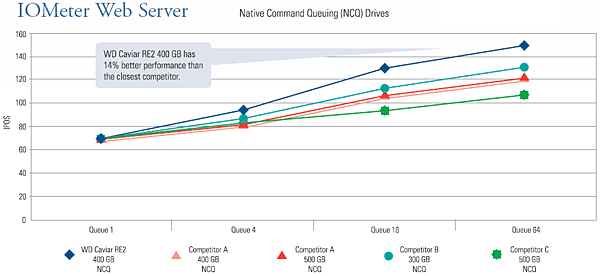 It's not difficult to guess the competing SATA drives: top models of Seagate Barracuda 7200.8 and 7200.9 (Competitor A), Maxtor MaXLine III (Competitor B), and Hitachi Deskstar 7K500 (Competitor C). What concerns the WD4000KD model, it does NOT officially support NCQ (see, for example, this page), like the other Caviar SE16 drives (we have already reviewed this issue in detail). But this feature may still be available optionally. That is some WD4000KD models support NCQ (for example, many models from the early shipments; that was why some misinformed reviewers decided that WD4000KD drives always offered NCQ support). But a number of later WD4000KD shipments, like the majority of Caviar SE16, came shipped without NCQ support. It's very easy to distinguish between WD4000KD drives with and without NCQ support: the third symbol in the firmware designation (to be more exact — in the name of the modification, because firmware revision is called differently) indicates NCQ support — "M" means that NCQ is disabled, "N" means that NCQ is supported. For example, we tested WD4000KD drives with NCQ support (00NAB0, see the screenshot). Also note that both drives we tested (WD4000KD and WD4000YR) happened to have the same firmware version (01.06A01)!  However, we have tested WD4000KD in two modes — with NCQ and without NCQ, in order to detect possible problems. :) In brief, the essence of the problem with NCQ in WD drives (that is the reason why the company started manufacturing some of its desktop drives with disabled NCQ, though these drives are nominally capable of NCQ support) is that, for example, WD4000KD with enabled NCQ demonstrates noticeably worse performance in a number of desktop applications and tests than it does without NCQ (WD publicly admitted it in the WD4000KD presentation): 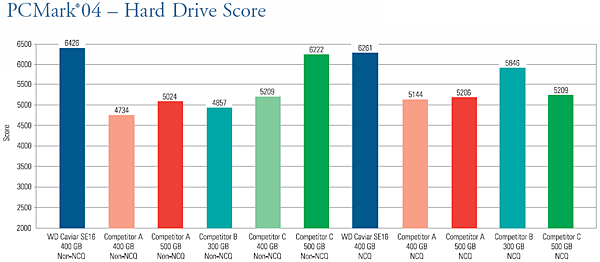  You can easily guess that Competitor A/B/C mean the following models:
So a "common desktop user" will have to think twice before using NCQ with WD4000KD and WD4000YR. We'll try to help you here with a fundamental analysis. Let's try to determine the cause of the problem. A WD4000KD user may have another doubt, when he tries to find out the interface type of this drive. Some retailers (in price lists) and some diagnostic utilities (for example, see the previous screenshot and pay attention to the difference from the same screenshot for WD4000YR!) inform us about Serial ATA II support, though the manufacturer (in specifications) and drivers of SATA II controllers report that this drive supports only the first generation of Serial ATA - 1.5 Gbit/s.  So you shouldn't expect 3 Gbit/s from these two WD drives. :) But this interface speed appears in all the other Caviar SE16 and Caviar RE2 hard drives (see Table 1). Those drives have a label on the case with instructions how to switch between 1.5 Gbit/s and 3 Gbit/s interface speeds. In case of WD4000KD and WD4000YR, you can use jumpers on the interface face of the case only to change SSC and PM2: 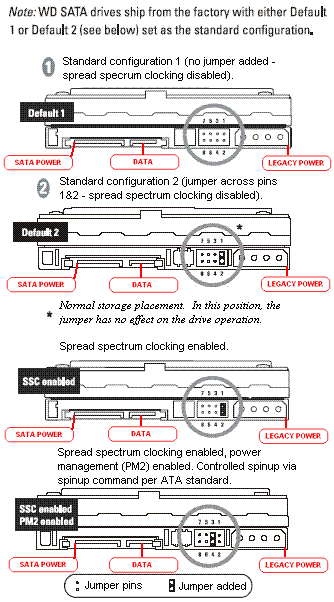 The manufacturer recommends the following applications for Caviar RE2:
WD stresses that "for high performance desktop applications, consider WD Caviar SE16 drives" (WD4000KD and the like)! (Speaking of multiple posts in forums about buying WD4000YR for a home PC and enjoying its reliability and high performance). :) What concerns WD4000KD, the manufacturer stresses that these drives are "designed for use in the fastest PCs on the market, including high-performance business computers, multimedia and gaming systems." :) Such drives are equipped with three traditional WD technologies - Data Lifeguard, Data Lifeguard Tools, and ShockGuard.
Test participantsOur today's comparison includes WD4000YR and WD4000KD drives. Information about them is published on the screenshots above. Note that these drives are actually from different series, but they have the same firmware version - 01.06A01. WD4000KD supports NCQ, but we shall test it on the same controller (SiI3124-2) both with NCQ support and without it. By the way, both drives (to be more exact, all the six samples of such drives, tested in our lab) refused to work correctly with the ICH5R bridge on the ABIT IC7-G motherboard (with the latest BIOS version). Though WDxxxxKS drives, for example, had no such problems with compatibility (it's probably the fault of a special controller in WD4000KD/YR models). That's why we tested WD4000YR and WD4000KD drives only with the SiI3124-2 controller. For comparison's sake, we have taken various hard drives of a similar class from our previous reviews. To make test results clearer, most competitors have been also tested with the SiI3124 controller: test results of SiI3124-based drives are published in the upper part of the diagrams. NCQ usage in drives supporting NCQ is properly marked on the diagrams (if not specified, it means enabled NCQ with SiI3124). Nevertheless, in case of some hard drives, we decided to publish test results with the ICH5R controller as well (of course, without NCQ support) — these results are grouped in 3-4 bottom lines on the diagrams under the "ICH5R:" title.
Performance Test ProcedureTestbed for ATA drives:
The hard drives were mounted firmly on the metal racks of a chassis and connected to the SiI3124-2 controller (PCI32/33) and ICH5R bridge on the motherboard. We have tested WD4000KD on the SiI 3124 controller with enabled (by default) NCQ support as well as with disabled (in the registry) NCQ support. The tests were carried out under MS Windows XP Professional SP1. The hard disks were tested not partitioned (in Intel Iometer, H2Benchw and AIDA32 tests) as well as partitioned and formatted by regular operating system tools depending on a test type: one NTFS partition of maximum size for testing the average access time and plotting the read speed graph in WinBench 99 and two NTFS or FAT32 partitions of the same size for other tests (WinBench Disk WinMark 99, copying files with various patterns, ATTO Disk Benchmark test, multithreaded read/write Nbench 2.4 test and the hard disk speed test in Adobe Photoshop). Each NTFS partition occupied half of the entire disk capacity (that is the second partition started exactly from the second half of the disk). FAT32 partitions were 32768 MB, the first one starting at the outer edge of the media (on the "fastest" tracks), and the second — exactly from the middle of the media volume. NTFS and FAT32 cluster sizes were selected by default — 4 and 16 KB correspondingly. We used AIDA32, H2benchw, and WinBench 99 tests to find out physical characteristics of drives (average access time, interface transfer rates, and linear disk transfer rates). To estimate the overall performance we use multiple patterns from Intel Iometer, a good test C'T H2Benchw, Adobe Photoshop swapping performance, multithreaded read/write, and the generally recognized WinBench 99 (though we don't pay much attention to the latter in our conclusions, because we have often found out about drive and controller optimizations for this test).
Baseline Test ResultsFirst of all, we are going to publish linear reading graphs (click on them to see full-size pictures). You can easily notice that linear reading graphs of WD4000YR and WD4000KD drives are identical. It could be easily predicted. ;) But if we compare them with graphs of the WD3200JD and WD2500KS on 100GB platters, the 400GB model is generally a tad faster than the 250GB model (equal outer tracks, but different zoning) and a tad slower than the 320GB model, which platters are formatted to 107GB. The following diagram confirms it: 100GB platters in 400GB drives are generally faster by 3% than the same platters in 250GB WD drives of the same generation. At the same time, all these WD drives are usually outperformed in linear access rates by competing models of the latest generation (Seagate, Samsung, and Hitachi). They outperform only Maxtor drive on 100GB platters (end of 2004 - beginning of 2005). There are no surprises concerning Serial ATA interface rates — WD drives demonstrate decent results, sometimes even outperforming the traditional leaders from Hitachi. Interestingly, the WD4000KD/YR controller even outperforms a more progressive single-chip solution for SATA II (WD2500KS), though PCI bus limits the throughput to 110 MB/s. What concerns the average access time, 400GB WD drives demonstrate good results for their class, though they are slightly outperformed by similar drives from Hitachi and Seagate. But they still outperform, for example, seek time for WD2500KS, Samsung and Maxtor MaXLine III. Perhaps, those 0.2 ms of the difference between seek times in WD4000YR and WDxxxxKS in the specification really exist in practice. We can try to judge about the efficiency of firmware procedures of lazy write and caching data for writing by the drop of the average write access time, measured by the operating system, relative to the read access time with enabled write-back caching. For this purpose we use the results of C'T H2benchW and IOmeter. WD4000xx caches random write data on the same level as the less capacious WD drives with 16 MB buffers. On the whole, this level is good enough, though a tad worse than in the latest 250GB drives from Hitachi and Samsung with 8MB buffers. And it's much worse than in Maxtor drives with 16MB buffers. So, WD programmers should work on more efficient usage of the twice as large buffer. Results of the same comparison in IOmeter confirm our conclusions, though they demonstrate a tad higher (by 0.01-0.2 ms) access times. Another illustrative test of the "interior design" and the firmware efficiency of the hard disks is the read/write speed on files of various sizes with various block sizes — from 512 bytes to 1 MB. For this purpose we use ATTO Disk Benchmark. The screenshots below display the results for the four sizes of a test file — 128KB, 1MB, 4MB, and 32MB. While the first and the second file sizes are, as a rule, surely cached in the disk buffer (caching read/write data for a 1MB file is not that simple), there is simply no room to fit in the last file size. Caching the last but one file size depends not only on the buffer size, but also on the hard disk firmware. This time we shall depart from our tradition and show the results of this test for three queue depths instead of only one: for Queue Depth (QD) 1, 4, and 9. They are published in animated gif files (QD=1, QD=4, and QD=9) for each traditional case. So each screenshot shows dynamics of HDD operation with data blocks of different size at different queue depths. It will help us to clear up the NCQ issue. :) (By the way, if you have a slow Internet connection and you want to see these animations run synchronously for better perception, you may reload the page using the cache of your browser. I've tried it myself on a relatively slow DSL line.)
WD Caviar's results in ATTO Disk Benchmark 2.02.
Results of this test set us thinking... About the drives, of course. :) These drives seem to be identical in controllers. They even have the same firmware version (judging by the number)... But their results are so different! At first, what concerns reading files, as the least problematic operation area of these drives. WD4000YR and WD4000KD act in practically the same manner when reading data (green columns), if NCQ is enabled. They demonstrate good performance at small as well as at large blocks, which reaches the caching limit (limited by the interface rate) for large blocks - 128KB and higher. Anticipatory reading (caching data for reading) is identically (highly) efficient with medium files (128-1024KB) as well as with large 4MB files. We can only welcome that (part of the service is done by the 16MB buffer). With the queue depth of one, the speed of NCQ-drives for reading blocks of all sizes is naturally lower (not much though, as the access is pseudo-sequential) than with the queue depth of 4 and 9 (there is almost no difference between the last two for reading; although QD=4 is doing slightly better in case of the smallest as well as 8KB blocks of a 32MB file.) But if we disable NCQ in the WD4000KD, we'll find out the speed of reading effectively cached files (that is 4MB files and smaller) will drop a little, though not much. The above-mentioned manner of caching data for reading will not change, though there will appear some fallouts for blocks of some sizes. That is these results prove that the firmware does not need NCQ for efficient anticipatory reading and caching files of up to 4MB. NCQ contributes little to the overall reading performance in this test. Now let's arm ourselves with nervine drops and proceed to writing (red columns on the diagrams; their color reflects perfectly our anxiety). :) First of all, let's have a look at the purest case, when NCQ is disabled — the right column of screenshots. The largest files (32MB) are written at practically the same speed as they are read. The slightly lower access rate at the smallest blocks QD=1 (versus QD=4 and 9) can be easily explained by caching (done by HDD firmware and probably by the controller.) So far so good. We are pleasantly surprised by the high speed with small blocks. Lazy write is getting more active with files smaller than 4MB (it's implemented by WD programmers with regard to 16MB cache.) In case of 4MB files and the queue depth of one, lazy write is efficient only with 64KB blocks and smaller. As the block size increases, the write rate drops to the level of a physical medium (that is lazy write actually stops being effective). But if the queue depth is increased to 4-9, lazy write becomes very efficient even with large blocks. It increases the write rate for such files nearly to the interface rate. The lazy write tendency is practically the same for 1MB files. But it gets a tad worse with 256-1024KB blocks. And finally, lazy write, implemented in WD4000KD, is just as highly effective for 128KB files as anticipatory reading. Only the smallest blocks (from 512 bytes to 4KB) and 1MB files are a disappointment. As the queue depth grows, lazy write gets more efficient. Though it's on a decent level anyway in the WD4000KD model — it's even better than for the WD2500KS from the same series, but with a different controller (also with disabled NCQ). Surprises appear, when we enable NCQ in these drives! Attention, people. Do you still believe that NCQ does not work for writing or that it's impossible in this case at all? :) Let's start with 32MB files again, they cannot be cached by the drive completely. WD4000KD on the same controller (with NCQ and without it) demonstrates practically identical results with NCQ and without it, if there is no request queue for writing. The same result is demonstrated with QD=1 by the WD4000YR with NCQ. That is the check point is passed successfully, let's start a command queue race. QD=4 for the WD4000KD with NCQ clearly demonstrates a significant drop in the write rate for 1-128KB blocks — proximity to the rates of a physical medium with 8-128KB blocks (as in case with disabled NCQ) is out of the question now! But when the queue depth is increased to 9 for 16-128KB blocks, the rate grows a little. But it's still too far from QD=1. The situation with WD4000YR (with NCQ) is almost no better: With QD=4, performance drop for 1-32KB blocks of a 32MB file is significant. Increasing queue depth to 9 results in slower performance for 8-128KB blocks. The conclusion is clear: NCQ support for writing in firmware of these drives conflicts with optimal lazy write algorithms (also in firmware) and it drops overall write performance of the hard drive. Let's proceed. Now what concerns writing 4MB and smaller files. As we saw on the right screenshots, lazy write performance of the WD4000KD can be quite efficient. While the results of all the three drives (with NCQ and without it) with QD=1 are very much the same (with little variations) and WD4000YR and WD4000KD's lazy write works almost perfectly for a 128KB file (performance goes down only with the largest blocks), the increase in queue depth for writing deteriorates the situation again. With QD=4 for 128KB files, the WD4000YR drive somehow tries to manage conflicts between the algorithms of lazy write and "native" command queue sorting (WD version) :), and this drive actually copes with this task for 64KB and smaller blocks. But QD=9 stupefies it as well — the write rate for 32-1024KB blocks drops very low. The WD4000KD is doing even worse with NCQ: with QD=4 and QD=9, its rate of writing a 128KB file is manifold (if not ten times) worse than without a command queue!!! Increasing the size of the test file to 1MB does not improve the situation much: in case of the WD4000KD with NCQ, the write rate for 1-64KB block drops much (several times!) with the appearance of a command queue (QD=4); though the situation with QD=9 is a tad better than with QD=4 for 32-128KB blocks. WD4000YR is again doing better than WD4000KD when writing files with enabled NCQ: the write rate for 0-32 (64) KB blocks benefits from the appearance of a queue. Performance drops only with QD=4 for 64-256KB blocks. And finally, NCQ helps the WD4000YR raise performance for a 4MB test file and 32, 64, 128 KB blocks (QD=4), though a longer queue has a negative effect. But the NCQ-modification of the WD4000KD again exposes its home front, if there appears a command queue for writing. Its performance drops much for small blocks (up to 32KB inclusive.) It's especially noticeable when compared to the situation with NCQ disabled on the host controller. Thus, our test results illustrate that the WD4000KD and WD4000YR drives can detect NCQ directives for writing. Their rates of processing various command queues are obviously different, when there are no NCQ directives from a host controller (or there is no command queue for writing). At the same time, it must be admitted that WD programmers did a poor job with NCQ support for writing — in the majority of cases, NCQ catastrophically conflicts with fine-tuned optimal algorithms of the classic lazy write in these drives with a large buffer; and the final write rate drops much with the appearance of a command queue. You can do only one thing to avoid it — disable NCQ support on the host controller, to which your WD drive is connected. But we should be fair - the WD4000YR and the WD4000KD with enabled NCQ act differently (that's still a mystery to me, considering their identical exteriors and firmware versions): professional WD4000YR acts according to its high status and loses write performance (still loses it ;)) from NCQ support much more rarely (and to a lesser degree) than its desktop counterpart (the latter sometimes "dies" in case of NCQ support and a command queue for writing). What concerns NCQ for reading, these WD drives demonstrate only positive effect from such support (in ATTO Disk Benchmark tests). However, we should bear out or falsify it in other tasks. As for now, we suggest you should think about what has been already written. In the second part of the article we'll find out how these peculiarities of the WD4000YR and WD4000KD drives with/without NCQ impact their performance in various consumer tasks and popular benchmarks. To be continued
Alex Karabuto (lx@ixbt.com)
May 25, 2006 Write a comment below. No registration needed!
|
Platform · Video · Multimedia · Mobile · Other || About us & Privacy policy · Twitter · Facebook Copyright © Byrds Research & Publishing, Ltd., 1997–2011. All rights reserved. | |||||||||||||||||||||||||||||||||||||||||||||||||||||||||||||||||||||||||||||||||||||||||||||||||||||||||||||||||||||||||||||||||||||||||||||||||||||||||||||||||||||||||||||||||||||||||||||||||||||||||||||||||||||||||||||||||||||||||||||||